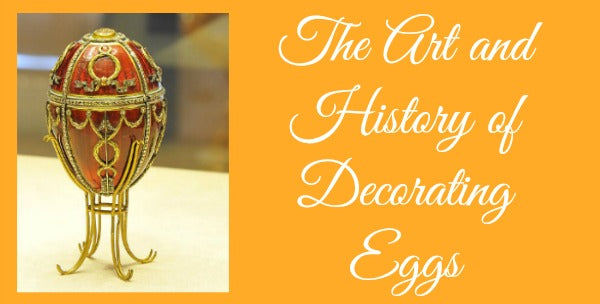The Art And History Of Decorating Eggs

It's almost Easter and almost time for my favorite holiday activity since I was young - decorating eggs!
My mom would get out all the coffee cups, fill them with water and a splash of vinegar. Then, she would get the food coloring from her baking supplies and add drops of color to each cup. Back then, the only colors in the food coloring pack were yellow, green, red, and blue, so if you wanted to make purple or orange, you had to know which colors to mix. It was a lesson in itself.
 Sometimes, if we wanted to get really artsy, we would create designs on them with white crayons. We wouldn't really know what the designs looked like until we dipped the eggs into the color. The wax in the crayon would resist the food coloring and the design would appear white on the colored egg. It was another lesson.
Sometimes, if we wanted to get really artsy, we would create designs on them with white crayons. We wouldn't really know what the designs looked like until we dipped the eggs into the color. The wax in the crayon would resist the food coloring and the design would appear white on the colored egg. It was another lesson.

 Pysanky Eggs are decorated in the wax resist, batik style. Although wax resist techniques are used throughout eastern Europe, the Pysanky Eggs are a particularly Ukrainian art form.
Pysanky Eggs are decorated in the wax resist, batik style. Although wax resist techniques are used throughout eastern Europe, the Pysanky Eggs are a particularly Ukrainian art form.
 Wycinanki eggs are a type of decorated eggs found in Poland. Paper is cut into flowers and animal shapes and applied directly to the egg.
Wycinanki eggs are a type of decorated eggs found in Poland. Paper is cut into flowers and animal shapes and applied directly to the egg.
 Possibly the most famous decorated eggs are the Fabergé Eggs created by Peter Carl Fabergé and his company for the Russian royal family from 1885 and 1917. The first Faberge egg was commissioned by Tsar Alexander III as an Easter gift for his wife, Tsarina Maria Fedorovna. Easter is the most important holiday in the Russian Orthodox Church and it was common to decorate eggs to celebrate. The Faberge eggs were the most elaborate of all.
The egg that Fabergé created in 1885 for Tsarina Maria Fedorovna is known as the "Hen Egg". It was created with gold and covered with an opaque white enamel to look like a real egg. The egg is divided by a band of gold in the middle where the egg can be opened. Inside the egg, there is a matte gold yolk and inside that a gold hen with ruby eyes. The hen can also be opened and originally a gold and diamond replica of the imperial crown with a tiny ruby pendant suspended from the crown. The Tsarina could wear the pendant on a separate necklace chain. These two final surprises have been lost.
Watch this video for more about the Hen Egg.
Possibly the most famous decorated eggs are the Fabergé Eggs created by Peter Carl Fabergé and his company for the Russian royal family from 1885 and 1917. The first Faberge egg was commissioned by Tsar Alexander III as an Easter gift for his wife, Tsarina Maria Fedorovna. Easter is the most important holiday in the Russian Orthodox Church and it was common to decorate eggs to celebrate. The Faberge eggs were the most elaborate of all.
The egg that Fabergé created in 1885 for Tsarina Maria Fedorovna is known as the "Hen Egg". It was created with gold and covered with an opaque white enamel to look like a real egg. The egg is divided by a band of gold in the middle where the egg can be opened. Inside the egg, there is a matte gold yolk and inside that a gold hen with ruby eyes. The hen can also be opened and originally a gold and diamond replica of the imperial crown with a tiny ruby pendant suspended from the crown. The Tsarina could wear the pendant on a separate necklace chain. These two final surprises have been lost.
Watch this video for more about the Hen Egg.
 Tsarevich Fabergé Egg - public domain photo from wikimedia commons
It is believed the Tsar was inspired by an elaborately decorated egg made for the Tsarina's father, the King of Denmark, that captivated her when she was young. Maria was captivated by the Fabergé egg, as well, so the tradition continued, eventually carried on by Alexander's son, Tsar Nicholas II.
Fabergé was commissioned year after year to created elaborately adorned eggs for the Russian royal family. He was given full creative license with the only stipulation being that the egg must open and contain a surprise. Of the 50 eggs created for the royal family, 44 are known to survive.
Tsarevich Fabergé Egg - public domain photo from wikimedia commons
It is believed the Tsar was inspired by an elaborately decorated egg made for the Tsarina's father, the King of Denmark, that captivated her when she was young. Maria was captivated by the Fabergé egg, as well, so the tradition continued, eventually carried on by Alexander's son, Tsar Nicholas II.
Fabergé was commissioned year after year to created elaborately adorned eggs for the Russian royal family. He was given full creative license with the only stipulation being that the egg must open and contain a surprise. Of the 50 eggs created for the royal family, 44 are known to survive.


 What works of art will you make with your Easter eggs? Share them with us on our Facebook page.
What works of art will you make with your Easter eggs? Share them with us on our Facebook page.

 Sometimes, if we wanted to get really artsy, we would create designs on them with white crayons. We wouldn't really know what the designs looked like until we dipped the eggs into the color. The wax in the crayon would resist the food coloring and the design would appear white on the colored egg. It was another lesson.
Sometimes, if we wanted to get really artsy, we would create designs on them with white crayons. We wouldn't really know what the designs looked like until we dipped the eggs into the color. The wax in the crayon would resist the food coloring and the design would appear white on the colored egg. It was another lesson.

The History Of Egg Decorating
For centuries, eggs have been a symbol of new life. Many cultures across Europe and the Middle East have long decorated eggs to celebrate spring, while other cultures put decorated eggs into the tombs of their loved ones and important leaders. In the Christian culture, eggs symbolize the resurrection of Christ. The hard shell represents the tomb and cracking the shell represents the tomb opening and the risen Christ emerging. Orthodox and Eastern Catholic churches traditionally dye eggs red at Easter to represent Christ's shed blood.Decorating Eggs As An Art Form
Bird eggs of all kinds have been turned into works of art for centuries. Emu and ostrich eggs thought to be thousands of years old have been found in South Africa decorated with carvings and engravings. The thickness of these large eggs makes the carving possible. Eastern Europeans, mainly Slavs, have a rich history of decorating chicken, duck, and goose eggs. These cultures use dyes, wax, scraping, and appliques to create beautiful works of art. Pysanky Eggs are decorated in the wax resist, batik style. Although wax resist techniques are used throughout eastern Europe, the Pysanky Eggs are a particularly Ukrainian art form.
Pysanky Eggs are decorated in the wax resist, batik style. Although wax resist techniques are used throughout eastern Europe, the Pysanky Eggs are a particularly Ukrainian art form.
 Wycinanki eggs are a type of decorated eggs found in Poland. Paper is cut into flowers and animal shapes and applied directly to the egg.
Wycinanki eggs are a type of decorated eggs found in Poland. Paper is cut into flowers and animal shapes and applied directly to the egg.
Fabergé Eggs
 Possibly the most famous decorated eggs are the Fabergé Eggs created by Peter Carl Fabergé and his company for the Russian royal family from 1885 and 1917. The first Faberge egg was commissioned by Tsar Alexander III as an Easter gift for his wife, Tsarina Maria Fedorovna. Easter is the most important holiday in the Russian Orthodox Church and it was common to decorate eggs to celebrate. The Faberge eggs were the most elaborate of all.
The egg that Fabergé created in 1885 for Tsarina Maria Fedorovna is known as the "Hen Egg". It was created with gold and covered with an opaque white enamel to look like a real egg. The egg is divided by a band of gold in the middle where the egg can be opened. Inside the egg, there is a matte gold yolk and inside that a gold hen with ruby eyes. The hen can also be opened and originally a gold and diamond replica of the imperial crown with a tiny ruby pendant suspended from the crown. The Tsarina could wear the pendant on a separate necklace chain. These two final surprises have been lost.
Watch this video for more about the Hen Egg.
Possibly the most famous decorated eggs are the Fabergé Eggs created by Peter Carl Fabergé and his company for the Russian royal family from 1885 and 1917. The first Faberge egg was commissioned by Tsar Alexander III as an Easter gift for his wife, Tsarina Maria Fedorovna. Easter is the most important holiday in the Russian Orthodox Church and it was common to decorate eggs to celebrate. The Faberge eggs were the most elaborate of all.
The egg that Fabergé created in 1885 for Tsarina Maria Fedorovna is known as the "Hen Egg". It was created with gold and covered with an opaque white enamel to look like a real egg. The egg is divided by a band of gold in the middle where the egg can be opened. Inside the egg, there is a matte gold yolk and inside that a gold hen with ruby eyes. The hen can also be opened and originally a gold and diamond replica of the imperial crown with a tiny ruby pendant suspended from the crown. The Tsarina could wear the pendant on a separate necklace chain. These two final surprises have been lost.
Watch this video for more about the Hen Egg.
 Tsarevich Fabergé Egg - public domain photo from wikimedia commons
Tsarevich Fabergé Egg - public domain photo from wikimedia commonsCreating Your Own Egg Art
You can create your own works of egg art. They don't have to be as adorned as the Faberge eggs or as intricate as pysanky eggs, but they can be just as creative and special. Try out some of these techniques with your kids.How To Carve Eggs - home-dzine.co.za
How To Create Pysanky Eggs - www.learnpysanky.com

Watercolor Eggs - ohmy-creative.com
Doodle Eggs - alisaburke.blogspot.com

Make Paper Mache Easter Eggs - firefliesandmudpies.com
 What works of art will you make with your Easter eggs? Share them with us on our Facebook page.
What works of art will you make with your Easter eggs? Share them with us on our Facebook page.














